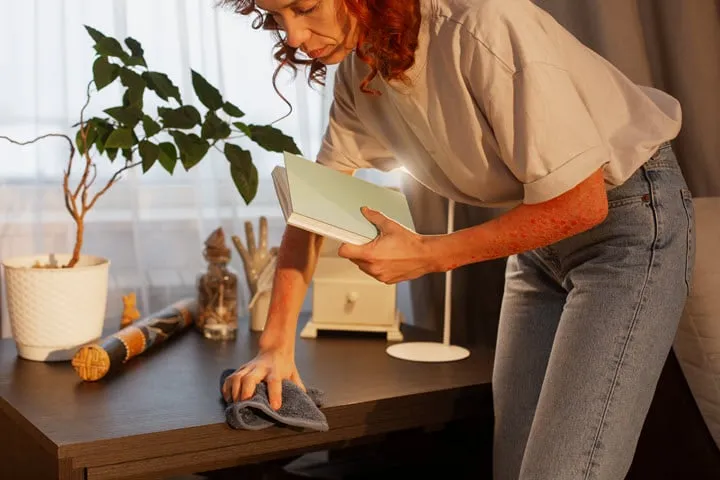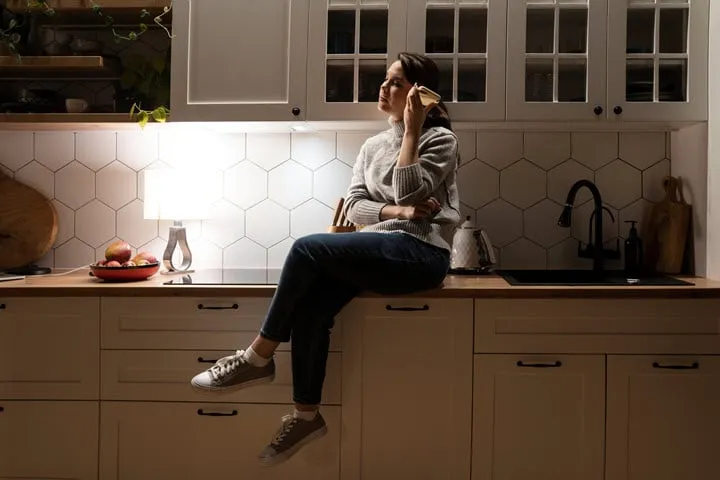Sharing is Caring!
Lets face it. We all want to get rid of dust in our homes but it seems like a neverending battle regardless of what we do. Dust can build up fast, but the right cleaning habits and a well-maintained HVAC system can make a big difference.
Understanding where dust comes from, and how air circulation and filtration affect it, will help you tackle the problem at the source and keep your home cleaner for longer.
Below, you’ll discover some of the best tips to get rid of dust in your home and keep it that way.
Why Is My Room So Dusty?
When we try to get rid of dust in home, it seems like a battle we never win. Moreover, dust doesn’t just appear from nowhere; it’s a mix of tiny particles shed or carried into your space.
In bedrooms especially, the main culprits are textile fibers from bedding, clothing, and carpets, along with skin cells and hair. Unfortunately, vacuuming doesn’t always do that trick, but it does help.
Add in airflow patterns that push particles into corners and under furniture, and you get visible buildup fast. If your room feels dustier than the rest of the house, it may be due to low ventilation (particles settle instead of filterer them out) or soft surfaces like rugs and curtains acting as dust traps. This kind of indoor dust is especially common in rooms with limited airflow.
Sometimes the issue isn’t “more dust”, it’s where dust settles and how air moves.
Your room might have negative air pressure pulling unfiltered air in from hallways, attics, or crawl spaces (bringing fine insulation fibers and outdoor particles), or electrostatic attraction from TVs, computer screens, and other electronics that pull dust to certain surfaces like magnets. This can increase dust in air even if the total amount in the house is the same.
Pro tip: If you notice dust mainly near vents or windows, that’s a sign your HVAC system or outdoor airflow is delivering unfiltered particles right into the space. If you’ve ruled out “normal” causes, check whether your room’s house dust patterns line up with air vent positions, electronics, or hidden gaps to other parts of the home.
What Causes Dust In A House – Get Rid Of Dust Fast
House dust is a blend of debris that generates from indoors and particles tracked or blown in from outside. It can include textile lint from clothes, furniture, and carpets; skin flakes and hair from people and pets; pollen, soil, and soot from open doors, windows, or air leaks; and combustion particles from candles, fireplaces, or cooking.
Construction work, even small repairs, can also release fine dust that lingers, increasing dust in the air.
Moreover, the exact mix in your home depends on location, habits, and building design; urban homes often have more soot and brake-dust particles, while rural homes see more pollen and soil.
Indoor dust can also carry microscopic paint and drywall particles released by friction from doors, windows, or even clothing brushing walls; shed skins from dust mites and other tiny insect debris; and cooking aerosols that cool into sticky particles, binding with lint to form stubborn clusters.
Furthermore, if your home is especially dusty, it may be a sign that airflow, filtration, or material wear is out of balance, making it harder to reduce dust in home effectively.
How Dust In The Air Hurts Indoor Air Quality
Dust is more than just an eyesore, it’s an airborne contaminant. Once disturbed, fine particles can stay suspended for hours, traveling deep into the respiratory system. Many carry allergens like pollen and pet dander, or toxic residues such as lead, pesticides, and flame retardants from furniture.
Particle size and composition determine their impact: PM2.5 dust (smaller than 2.5 microns) can bypass natural defenses, reaching deep lung tissue and even entering the bloodstream; organic dust can feed bacteria and mold in damp areas; and synthetic dust from carpets, foam cushions, or plastics can carry chemicals that may disrupt hormones over time.
Health effects range from worsening allergies and asthma to eye and skin irritation, and increased respiratory symptoms in children, seniors, and those with chronic illnesses. Long-term exposure to dust in air with chemical contaminants adds cumulative risks, making dust control part of maintaining good indoor air quality, not just keeping things tidy.
Overlooked Sources Of Indoor Dust – Get Rid Of Dust The Smart Way
Even the cleanest homes can have sneaky dust sources.
More so, uncleaned HVAC ducts may distribute fine debris throughout the house. Of course, mattresses, pillows, carpets, and old padding shed fibers and collect skin cells daily. Books, paper stacks, and decor with textured surfaces, like artificial plants and picture frames, trap microdust over time.
Furthermore, ceiling fan blades scatter accumulated dust whenever they run. Additionally, dryer lint from laundry areas can travel far if the vent iif you don’t seal it correctly.
Gaps around light fixtures, attic hatches, and window or door frames can let in insulation particles or shed wood and paint dust. Indoor plants can contribute soil particles, pollen, and spores, adding to house dust buildup.
Simple Trick To Eliminate Dust In Your House
The fastest improvement often comes from filtering the air continuously. Run a high-quality HEPA air purifier in the most-used rooms, or upgrade your HVAC or heat pump filter to a MERV 11–13 rating (if your system supports it). This traps airborne dust in the air before it settles, cutting visible buildup within a week or two, without extra cleaning effort.
To control dust in house at the point of entry, place commercial-grade entry mats outside and inside the front door, and clean them weekly.
Add weatherstripping and door sweeps to block dust-laden drafts, and for high-traffic homes, consider a portable shoe sanitizer or cleaner. Stopping dust before it gets inside is far easier than chasing it once it spreads.
Clean Without Spreading Dust In Air
Dry dusting with a feather duster just sends particles into the air. Treat cleaning like dust extraction, not dust relocation. Use a damp microfiber cloth or lightly mist surfaces with a water and vinegar solution.
Ideally, this allows fibers to grab particles instead of pushing them around, working from top to bottom, so you don’t pick up falling in the next step.
For electronics, use a slightly damp microfiber or an electrostatic duster to avoid pushing indoor dust into fans and vents.
Vacuum first, ideally with sealed HEPA filtration, so particles don’t blow out the back of the machine. This is especially important before dusting shelves, vents, baseboards, and behind furniture, which are prime dust reservoirs. For high shelves, wrap a microfiber cloth around a paint roller for wide, controlled swipes without scattering particles.
How To Prevent And Get Rid Of Dust
Dust control is about reducing sources and improving capture. Declutter surfaces so dust in house has fewer places to settle, switch to low-shedding textiles like tightly woven cotton, and wash bedding weekly in hot water to remove skin cells and fibers.
Moreover, groom pets regularly to reduce dander and loose fur, and keep shoes at the door since we track in floor dust.
Seal air leaks around windows and doors to block outdoor particles, and maintain your HVAC system with a high-grade filter. Make sure you run the fan on low for a few hours daily so the airborne dust in the air keeps moving until you trap it.
Furthermore, controlling humidity between 40-50% is crucial. Low humidity makes indoor dust lighter and more airborne, while high humidity causes it tostick and clump.
Rotate and deep-clean hidden dust reservoirs, like the tops of cabinets and behind appliances, every few months to break the cycle. A consistent, layered approach, source control, regular cleaning, and filtration will reduce dust in the home and improve indoor air quality for the long term.
We hope these tips on how to get rid of dust in your home help you get things under control.
Sharing is Caring!
Disclaimer: This story is auto-aggregated by a computer program and has not been created or edited by jennertrends.
Publisher: Source link













